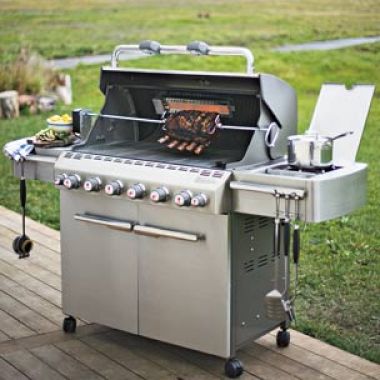
The two most popular types of outdoor grills are kettle-shaped charcoal grills and propane- or natural gas-fueled grills. Both styles allow direct-heat grilling, indirect-heat grilling and smoking.
Charcoal Grills
The primary advantage of a charcoal grill is the smoky flavor that hardwood and charcoal impart to your food. The smallest charcoal grills, such as Japanese-style hibachis,are especially convenient for balcony or patio use. Although easily portable, these small grills limit the quantity and size of the foods you cook.
If you are an avid outdoor cook and plan to use the grill regularly, you may want to invest in a large, sturdy charcoal grill that will last for years. A popular and versatile choice is the kettle-shaped grill because the deep, rounded base and domed cover make it fuel efficient and let you grill with direct or indirect heat. These covered grills also allow you to continue cooking when the weather turns windy or rainy. Vents on the base and cover help you control the temperature inside the grill. Kettle grills may include wheels, removable ash catchers, wire shelves and cart frames. Some models feature gas ignition systems that make lighting the charcoal as easy as pushing a button.
Gas Grills
Even though a gas grill will not give your food the smoky flavor possible with hardwood or charcoal, a gas grill can make cooking and cleanup more convenient. Gas grills let you regulate heat with the turn of a dial. Most models include multiple controls so you can heat just part of the grill, which is helpful when grilling with indirect heat. Because drippings are vaporized to create smoke and excess grease is channeled off to prevent flare-ups, cleaning a gas grill is easier than cleaning a charcoal one.
Whether fueled by propane in refillable tanks or a natural-gas line that connects to the house, a gas grill emits flames that heat a bed of ceramic briquettes, heat-absorbent crushed lava rock, or stainless-steel or enameled metal baffles (devices to regulate the flow of gas), which in turn cook food placed on a rack above them. Gas grill options include separate burners for cooking sauces or heating griddles, rotisseries for spit-roasting, and metal boxes that hold wood chips for smoking. The grill hood allows for indirect-heat grilling and for smoking. When selecting a gas grill, choose one with more than one heat element so the grill can be used for cooking with indirect heat.
Good-sized covered grills can easily handle enough food to feed a crowd and are usually designed to cook a big cut of meat or a whole bird by indirect heat. If cared for properly, they will last season after season.
Other Grills
In theory, you can grill with indoor electric grills and grill pans just as you would outdoor grills, but because indoor grills lack a cover, their use is limited to cooking over direct heat. Most recipes for direct-heat grilling successfully make the move to indoor equipment. Cooking indoors may take longer, however, as these grills generally do not get as hot as outdoor gas or charcoal grills. Before you start, make sure your kitchen has adequate ventilation to whisk away smoke and odors.
Above all, whether choosing a small hibachi for cooking on a fire escape or a deluxe gas model with every imaginable accessory, look for a grill that requires little or no assembly and has solidly welded parts. A generous warranty issued by a respected manufacturer is also an assurance of quality.
Adapted from Williams-Sonoma, Essentials of Grilling, by Denis Kelly, Melanie Barnard, Barbara Grunes & Michael McLaughlin (Oxmoor House, 2003).











